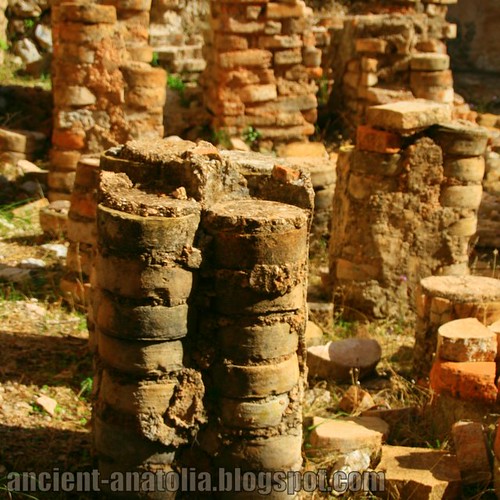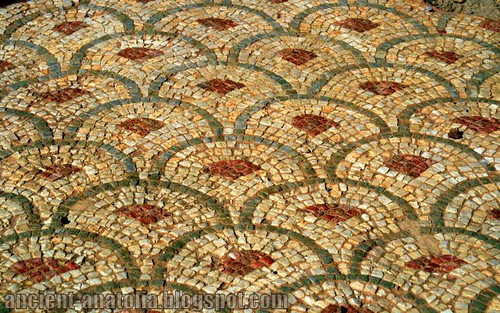
Circular Pilae Stacks of Arykanda, originally uploaded by voyageAnatolia.blogspot.com.
Rare Circular Roman Pilae Stacks of Arykanda
This architectural technique was the first form of underfloor heating and the same principle is still used today.
Arykanda (Arycanda) is an ancient Lycian city, built upon five large terraces ascending a mountain slope, located near the small village of Aykiricay, on the Elmali-Finike road in Antalya province in south western Turkey ... read more
Pilae Stacks are stacks of pilae tiles, square thin tiles, that were used in Roman times as an element of the underfloor heating system, common in Roman bathhouses, called the hypocaust. The concept of the Pilae stacks is that the floor is constructed at an elevated position, allowing air to freely circulate underneath and up, through the hollow bricks, into the structure walls. Examples of such baths are found not only in Rome, but also in Roman Britain and distant parts of the Roman Empire such as the baths at Chellah, in modern day Morocco.
Circular pilae do not particularly improve the thermal inertia of the hypocaust; moreover, the circular earthenware bricks require more careful handling during manufacture, transportation, and laying. Consequently, the use of circular bricks for pilae construction must have been due to considerable mechanical advantages in balancing stresses and distributing loads by preventing buckling. An additional advantage conferred was the savings in raw material in the lack of edges, which bore no load in any case.
Hypocausts were used for heating public baths and private houses. The floor was raised above the ground by pillars, called pilae stacks, and spaces were left inside the walls so that hot air and smoke from the furnace (praefurnium) would pass through these enclosed areas and out of flues in the roof, thereby heating but not polluting the interior of the room. Ceramic box tiles were placed inside the walls to both remove the hot burned air, and also to heat the walls. Rooms requiring the most heat were placed closest to the furnace, whose heat could be increased by adding more wood to the fire. It was labour-intensive to run a hypocaust as it required constant attention to tend the fire, and expensive in fuel, so it was a feature of the villa and public baths.
Vitruvius describes their construction and operation in his work Sergius Orata in about 25 BC, adding details about how fuel could be conserved by designing the hot room or caldarium for men and women to be built next to one another, adjacent to the tepidarium so as to run the public baths efficiently. He also describes a device for adjusting the heat by a bronze ventilator in the domed ceiling.
Many remains of hypocausts have survived among Roman architectural ruins throughout Europe, western Asia, and northern Africa. The hypocaust is generally regarded as a major Roman invention which improved the hygiene and living conditions of citizens, and was a forerunner of modern central heating.
